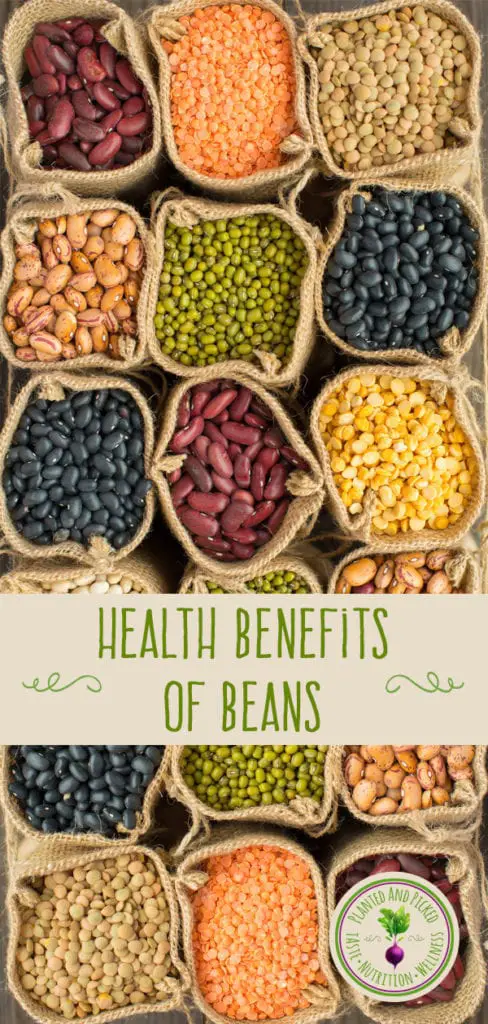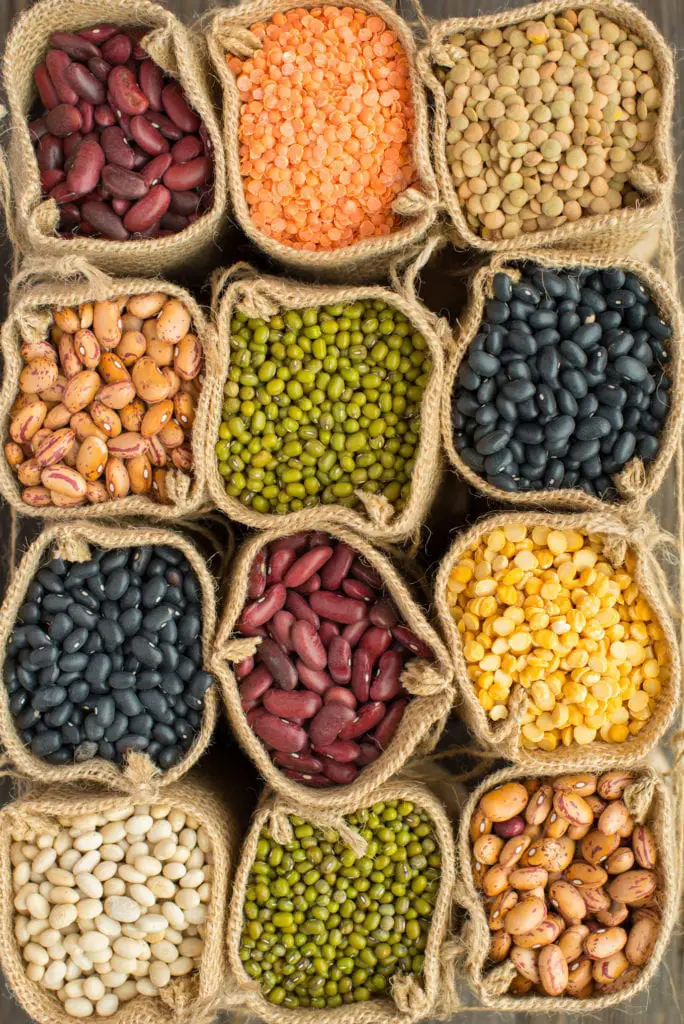

Beans are a subset of the broader classification of vegetables, ‘Legumes’. Legumes include other foods such as chickpeas, edamame beans and lentils. In this blog post about the health benefits of beans, I use the term interchangeably as most people are more familiar with the term ‘beans’.
Beans should be an integral part of a whole foods plant-based diet (WFPB). Even if you are not vegan, everyone should try to include beans in their diet on a daily basis. In the book ‘Becoming Vegan’, the authors recommend including a daily minimum of one serving of legumes. Dr. Michael Gregor, a proponent of plant-based eating, recommends at least three daily servings of beans!
Recommended bean consumption is likely easy for cultures that make them a staple. In the United States, the average bean consumption is about 3 kg per year. In countries where beans are a staple food, intake averages 40 kg per year. Intake is as high as 66 kg per year in some African countries. If you did not grow up with beans in your diet, you may have issues getting used to them. Let me first convince you why you need them and then show you how you can eat them more readily.
What Are the Health Benefits of Beans for Me?
Heart Healthy
Beans, Beans, good for your heart, the more you eat the more you fart….”. I think a lot of people grew up with this diddy, and for good reason. Turns out beans are very heart healthy. We’ll get to the farting part later. Beans are “heart healthy” because they contain an abundance of soluble fiber, which can lower cholesterol and triglyceride levels. Most beans are about 2 to 3 percent fat with no salt, unless you add it. If you prefer canned beans, you can remove up to 40 percent of the sodium by rinsing them in water. You can also buy unsalted canned beans. One study shows that legume consumption four times or more per week in comparison to less than once a week results in a 22% lower risk of coronary heart disease.
Blood Sugar Control
The glycemic load measures the glycemic index of a food and the amount of carbohydrates that it has. The scale ranges from 0 to 40. Foods ranked below 10 have a low glycemic load and will not significantly raise your blood sugar. Most beans have a glycemic load of 7. Beans can help to regulate blood sugar because they are so rich in dietary fibre. Fibre helps to lower and stabilize your blood sugar, even if you eat higher glycemic foods. This is because it prevents glucose from other foods from digesting quickly. As such, blood sugar and insulin levels are prevented from rising.
A study titled “Slow Release Dietary Carbohydrate Improves Second Meal Tolerance” demonstrated that the initial reduction in blood glucose after a breakfast including lentils, carries on to a second meal. The lentils resulted in a 71% reduction in blood glucose after breakfast. This also helped to reduce blood glucose after a standard bread lunch four hours later – as much as 38%! This is known as the ‘Second Meal Affect’.
Reduce Cancer Risk
According to Dr. Gregor’s book, “How Not to Die”, the most comprehensive analysis of diet and cancer ever performed was published in 2007 by the American Institute for Cancer Research. One of their summary cancer-prevention recommendations is to eat whole grains and/or legumes at EVERY MEAL. High fibre diets reduce the risk of cancer and beans are high in fibre. Try adding a few tablespoons of red lentils to your oatmeal. You won’t even notice they are there, and you get another boost of fibre with your breakfast.
Bowel Health
Another health benefit of beans is that they are filled with fibre and can promote regularity by preventing constipation. Beans contain on average 5 to 8 grams of fibre per 100g. Be sure to drink lots of water when eating high fibre food to help flush the bowels.
Nutrient Rich
Beans are a beautiful blend of carbohydrates, protein and fibre. They contain a powerhouse of nutrients including vitamins, minerals and antioxidants. See our post – Antioxidants and Foods Containing Them. Beans include minerals such as copper, folate, iron, magnesium, manganese, phosphorous, potassium, zinc and calcium. A serving of kidney beans, for example, contains about 143g of calcium.
Increase Longevity
Dan Buettner’s book “The Blue Zones” looked at diet and lifestyles of regions of the world with the most centurions. One of the summary points was that with all of these cultures, beans are a staple food. Evidence is provided in this study: “Legumes: the most important dietary predictor of survival in older people of different ethnicities”. This study showed that for participants who ate beans there was a 7-8% reduction in mortality hazard ratio for every 20g increase in daily intake.
How Can I Incorporate Beans Into My Diet
Beans can be part of a main dish (chili, curries, loaves, patties), a side dish (rice and beans), an appetizer (hummus), soups (Minestrone) or dips (Black bean). It’s easy to be creative when you have a range of bean types in your pantry. These may include kidney, pinto, lima and black beans, black-eyed peas, garbanzo beans (chickpeas), split peas and lentils. Take advantage of their various shapes, sizes and colors when planning meals. You can reap the health benefits of beans by trying out some our recipes including legumes: Vegan Red Lentil Chili; Vegan Mexican Chili with Real Chilis; Vegan Mexican Stuffed Peppers; Creamy Roasted Garlic Hummus; Italian Style Lentil Meatballs; Super Eggy Tofu Scramble; and Baked Tempeh Bacon Strips. Try our soups that also contain beans: Classic Italian Minestrone Soup; Quick and Easy Black Bean Soup; and Spring Detox Soup.
Dealing with Gas while Reaping the Health Benefits of Beans
Many people experience uncomfortable digestive symptoms after eating beans. This is due to the fibre as well as the antinutrient proteins called lectins. Soaking and cooking the beans will reduce bloat. This can also increase the bioavailability of health promoting vitamins and minerals.
A study by Windham DM, Hutchins addressed “Perceptions of flatulence from bean consumption among adults”. Adults adding one half cup of beans to their daily diet experienced an increase in flatulence during the first week. However, 70% of the same group found the effect dissipated by the second or third week of daily bean consumption.
A few things that you can do to build up your tolerance for beans:
- Start small. Include a couple of tablespoons of beans to a meal daily for the first week and gradually build up to higher amounts.
- You can also take a digestive enzyme with your bean meal that includes the enzyme alpha-galactosidase. The human body makes this enzyme but many people do not have enough.
- Soak dried beans overnight and discard the soaking water before cooking.
- Sprout beans. Small beans such as mung beans, lentils and peas can be eaten raw after spouting. Other beans should still be cooked.
- Rinse canned beans well prior to eating them in order to remove any of the additional sugars in the water that can be hard to digest.
- Choose smaller beans such as split peas or lentils that are easier to digest.
References
Some of the references made in this post are listed here:
- Becoming Vegan – The Complete Reference on Plant-Based Nutrition, Brenda Davis and Vesanto Melina, 2014
- Slow Release Dietary Carbohydrate Improves Second Meal Tolerance, Jenkins DJ, Wolever TM, Taylor RH, Griffiths C, Krzeminska K, Lawrie JA, Bennett CM, Goff DV, Sarson DL, Bloom SR, 1982
- How Not to Die – Discover the Foods Scientifically Proven to Prevent and Reverse Disease, Michael Greger, MD, 2015
- Legumes: the most important dietary predictor of survival in older people of different ethnicities, Darmadi-Blackberry I, Wahlqvist ML, Kouris-Blazos A, Steen B, Lukito W, Horie Y, Horie K, 2004
- Blue Zones – 9 Lessons For Living Longer, Dan Buettner, National Geographic Society, 2012




I want to take better care of my heart, but I’m not sure what kinds of foods I can eat for that. It’s good to know that legumes can be so good for your heart. It would be fun to see if I can grow and eat some of my own.
Hi Braden, yes, beans are good for the heart, particularly red kidney beans, as well as red foods! Think about things such as red onions, red grapefruit, pomegranate, beets and cherries 😊
Very informative and amazing post! I got to learn a lot of wonderful and interesting facts about Pulses. I will definitely follow it in my regular diet.
Thank you so much for leaving a comment. We usually have beans at least once a day. Today it was at lunch in Minestrone soup. If you try any of our recipes including beans, be sure to let us know!